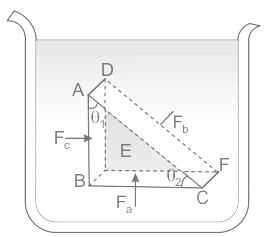Civil Engineering (CE) Exam > Civil Engineering (CE) Questions > Pascals law states that pressure at a point i...
Start Learning for Free
Pascal's law states that pressure at a point is equal in all directions, in a
- a)static solid
- b)static fluid
- c)static gas
- d)moving fluid
Correct answer is option 'B'. Can you explain this answer?
Most Upvoted Answer
Pascals law states that pressure at a point is equal in all directions...
Concept:
According to Blaise Pascal, a French scientist observed that the pressure in a fluid at rest is the same at all points if they are at the same height and it is termed Pascal’s Law.
According to Blaise Pascal, a French scientist observed that the pressure in a fluid at rest is the same at all points if they are at the same height and it is termed Pascal’s Law.

Proof of Pascal's law. ABC-DEF is an element of the interior of a fluid at rest. This element is in the form of a right-angled prism. The element is small so that the effect of gravity can be ignored, but it has been enlarged for the sake of clarity
i.e., the pressure exerted by the fluid on an object at a certain height will be the same in all direction and hence it can be expressed as

From the above fig. we can see that the force against area within a fluid at rest will always experience pressure perpendicular to their surface area, and the object will experience equal pressure throughout the surface.
And there are a number of devices, such as hydraulic lift and hydraulic brakes, are based on Pascal’s law, these devices used fluids for transmitting pressure.
Free Test
FREE
| Start Free Test |
Community Answer
Pascals law states that pressure at a point is equal in all directions...
Static Fluid
Pressure in a fluid at rest is the same in all directions, as stated by Pascal's law. This means that if pressure is applied at one point in a static fluid, it gets transmitted equally in all directions without any loss of intensity.
Explanation
- Pascal's Law: This law is based on the principle that fluids cannot support shear stress, which means they cannot resist forces that try to deform them. Therefore, when an external pressure is applied to a static fluid, it gets distributed uniformly in all directions due to the fluid's inability to resist deformation.
- Equal Pressure: In a static fluid, the pressure at any given point is the same in all directions. This is because the fluid molecules can easily move and adjust themselves to transmit the pressure equally in all directions.
- Hydraulic Systems: Pascal's law is essential in the design and functioning of hydraulic systems, where pressure applied at one point can be transmitted through the fluid to create a desired force at another point. This principle is widely used in various applications, such as hydraulic lifts, brakes, and machinery.
- Applications: Understanding Pascal's law in static fluids is crucial for engineers and designers working with hydraulic systems. By ensuring that pressure is distributed equally, they can design efficient and reliable systems that operate smoothly without any loss of force or energy.
In conclusion, Pascal's law applies to static fluids, where pressure is uniform in all directions. This principle is fundamental in the field of fluid mechanics and is used in various engineering applications to create effective hydraulic systems.

|
Explore Courses for Civil Engineering (CE) exam
|

|
Question Description
Pascals law states that pressure at a point is equal in all directions, in aa)static solidb)static fluidc)static gasd)moving fluidCorrect answer is option 'B'. Can you explain this answer? for Civil Engineering (CE) 2025 is part of Civil Engineering (CE) preparation. The Question and answers have been prepared according to the Civil Engineering (CE) exam syllabus. Information about Pascals law states that pressure at a point is equal in all directions, in aa)static solidb)static fluidc)static gasd)moving fluidCorrect answer is option 'B'. Can you explain this answer? covers all topics & solutions for Civil Engineering (CE) 2025 Exam. Find important definitions, questions, meanings, examples, exercises and tests below for Pascals law states that pressure at a point is equal in all directions, in aa)static solidb)static fluidc)static gasd)moving fluidCorrect answer is option 'B'. Can you explain this answer?.
Pascals law states that pressure at a point is equal in all directions, in aa)static solidb)static fluidc)static gasd)moving fluidCorrect answer is option 'B'. Can you explain this answer? for Civil Engineering (CE) 2025 is part of Civil Engineering (CE) preparation. The Question and answers have been prepared according to the Civil Engineering (CE) exam syllabus. Information about Pascals law states that pressure at a point is equal in all directions, in aa)static solidb)static fluidc)static gasd)moving fluidCorrect answer is option 'B'. Can you explain this answer? covers all topics & solutions for Civil Engineering (CE) 2025 Exam. Find important definitions, questions, meanings, examples, exercises and tests below for Pascals law states that pressure at a point is equal in all directions, in aa)static solidb)static fluidc)static gasd)moving fluidCorrect answer is option 'B'. Can you explain this answer?.
Solutions for Pascals law states that pressure at a point is equal in all directions, in aa)static solidb)static fluidc)static gasd)moving fluidCorrect answer is option 'B'. Can you explain this answer? in English & in Hindi are available as part of our courses for Civil Engineering (CE).
Download more important topics, notes, lectures and mock test series for Civil Engineering (CE) Exam by signing up for free.
Here you can find the meaning of Pascals law states that pressure at a point is equal in all directions, in aa)static solidb)static fluidc)static gasd)moving fluidCorrect answer is option 'B'. Can you explain this answer? defined & explained in the simplest way possible. Besides giving the explanation of
Pascals law states that pressure at a point is equal in all directions, in aa)static solidb)static fluidc)static gasd)moving fluidCorrect answer is option 'B'. Can you explain this answer?, a detailed solution for Pascals law states that pressure at a point is equal in all directions, in aa)static solidb)static fluidc)static gasd)moving fluidCorrect answer is option 'B'. Can you explain this answer? has been provided alongside types of Pascals law states that pressure at a point is equal in all directions, in aa)static solidb)static fluidc)static gasd)moving fluidCorrect answer is option 'B'. Can you explain this answer? theory, EduRev gives you an
ample number of questions to practice Pascals law states that pressure at a point is equal in all directions, in aa)static solidb)static fluidc)static gasd)moving fluidCorrect answer is option 'B'. Can you explain this answer? tests, examples and also practice Civil Engineering (CE) tests.

|
Explore Courses for Civil Engineering (CE) exam
|

|
Signup for Free!
Signup to see your scores go up within 7 days! Learn & Practice with 1000+ FREE Notes, Videos & Tests.


















